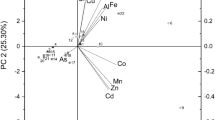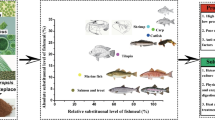Abstract
The specific features of accumulation of fat, protein, mineral, and nitrogen-free extractive substances in the skeletal muscles of bream (Abramis brama L.) from areas of the Rybinsk reservoir subjected to different degrees of anthropogenic load have been studied. Data on the bream forage base and feeding in the reservoir are presented. It is shown that, in the areas of the Sheksninskii Reach with high food capacity located in the zone of long-term local anthropogenic pollution, the feeding intensity of bream decreases. This leads to a decrease in fish conditions and amount of fat and mineral substances in their muscle tissues when compared with specimens from conditionally clean stations in the Mologa and Volga reaches with high food capacity.

Similar content being viewed by others
REFERENCES
Bakanov, A.I., Krasnoper, E.V., and Strizhnikova, L.N., Ob ispol’zovanii indeksov pri izuchenii pitaniya ryb-bentofagov (The Use of Indices in the Study of Nutrition of Benthophagous Fishes), Available from VINITI, 1980, Inst. Biol. Vnutr. Vod, Akad. Nauk SSSR, no. 4984-80.
Belan, T.A., Characteristics of abundance and species composition of benthos under conditions of pollution: Peter the Great Bay, Sea of Japan, Extended Abstract of Cand. Sci. (Biol.) Dissertation, Vladivostok, 2001.
Gerasimov, Yu.V., Brazhnik, S.Yu., Strel’nikov, A.S., et al., Bream, in Ryby Rybinskogo vodokhranilishcha: populyatsionnaya dinamika i ekologiya (Fishes of the Rybinsk Reservoir: Population Dynamics and Ecology), Yaroslavl: Filigran’, 2015, pp. 198–223.
German, A.V. and Zakonnov, V.V., Accumulation of polychlorinated biphenyls in the Sheksninskii Pool of the Rybinsk Reservoir, Water Resour., 2003, vol. 30, no. 5, pp. 524–528.
German, A.V., Zakonnov, V.V., and Mamontov, A.A., Organochlorine compounds in bottom sediments, benthos, and fish in the Volga Pool of the Rybinsk Reservoir, Water Resour., 2010, vol. 37, no. 1, pp. 84–88.
German, A.V. and Kozlovskaya, V.I., Gepatosomatic index and the biochemical composition of the liver in Abramis brama in the Sheksna Stretch of the Rybinsk Reservoir at different levels of toxicant accumulation, J. Ichthyol., 2001, vol. 41, no. 2, pp. 160–163.
German, A.V. and Kozlovskaya, V.I., Levels of polychlorinated biphenils in Abramis brama of the Rybinsk Reservoir, J. Ichthyol., 1999, vol. 39, no. 1, pp. 133–136.
Golovanova, I.L., Filippov, A.A., Levin, B.A, et al., Effect of heavy metals (Cu, Zn, Pb) on the activity of intestinal glycosidases of zope and silvereye, in Materialy V Vserossiiskoi konferentsii po vodnoi ekotoksikologii “Antropogennoe vliyanie na vodnye organizmy i ekosistemy” (Proc. V Conf. on Aquatic Ecotoxicology “Anthropogenic Impact on Aquatic Organisms and Ecosystems”), Yaroslavl, 2014, pp. 33–36.
Goryunova, A.I. and Dan’ko, E.K., Piscicultural development of steppe lakes in Kazakhstan. Commercial cultivation of the bream (on the issue of the reconstruction of lake-commodity farms, Izv. Nats. Akad. Nauk Resp. Kazakhstan, Ser. Biol. Med., 2014, no. 6, pp. 7–11.
Zhiteneva, T.S., Bream nutrition in different biotopes of the Rybinsk reservoir, Biol. Vnutr. Vod: Inform. Byull. (Leningrad), 1980, no. 48, pp. 37–41.
Zabotkina, E.A., Health assessment of the bream Abramis brama L. from reaches of the Rybinsk Reservoir differing in the level of pollution by the cytological and histological parameters of the spleen, in Materialy V Vserossiiskoi konferentsii po vodnoi ekotoksikologii “Antropogennoe vliyanie na vodnye organizmy i ekosistemy” (Proc. V Conf. on Aquatic Ecotoxicology “Anthropogenic Impact on Aquatic Organisms and Ecosystems”), Yaroslavl, 2014, pp. 52–56.
Zinov'ev, E.A. and Kitaev, A.B., The role of chemical pollution in the formation and characteristics of the ichthyofauna of the Kama Reservoir in the vicinity of the Solikamsk–Berezniki industrial complex, Geograf. Vestn., 2011, no. 2, pp. 59–65.
Kasumyan, A.O., Effects of chemical pollutants on foraging behavior and sensitivity of fish to food stimuli, J. Ichthyol., 2001, vol. 41, no. 1, pp. 76–87.
Klochkova, N.G., Klimova, A.V., Ocheretyana, S.O., et al., The impact of anthropogenic pollution on the state of macrobenthos in Rakovaya Bay (Avacha Bay, southeastern Kamchatka), Vestn. Kamchat. Gos. Tekhn. Univ., 2016, no. 35, pp. 53–64.
Kozlovskaya, V.I. and German, A.V., Polychlorinated biphenyls and polyaromatic hydrocarbons in the ecosystem of the Rybinskoe Reservoir, Water Resour., 1997, vol. 24, no. 5, pp. 520–526.
Kozlovskaya, V.I., German, A.V., and Kozlovskaya, O.I., Polychlorinated biphenyls, in Ekologicheskie problemy Verkhnei Volgi (Environmental Problems of the Upper Volga), Yaroslavl: Izd. Yaroslav. Gos. Tekhn. Univ., 2001, pp. 243–248.
Kuz'mina, V.V., Gladkov, A.V., and Baranov, D.A., The influence of the food structure on the dynamics of motor reactions and diet of carp, Vestn. Agroprom. Kompleksa Verkhnevolzh’ya, 2011, no. 2, pp. 28–33.
Lapirova, T.B., Chuiko, G.M., and Pryanichnikova, E.G., Some immunophysiological parameters of Dreissena polymorpha from the Rybinsk Reservoir areas differing in the degree of anthropogenic impact, Vestn. Tver. Gos. Univ., Ser. Biol. Ekol., 2012, no. 25, pp. 64–75.
L'vova, A.A., Ecology of the zebra mussel (Dreissena polymorpha polymorpha (Pall.)), in Bentos Uchinskogo vodokhranilishcha (Benthos of the Ucha Reservoir), Moscow: Nauka, 1980, pp. 101–119.
Marenkov, O.N., Fedonenko, E.V., Gabibov, M.M., et al., Development of gonads of the bream (Abramis brama Linnaeus, 1758) under conditions of the Zaporozhye Reservoir, Izv. Vuzov Povolzh. Regiona, Estestv. Nauki, 2013, no. 4 (4), pp. 25–35.
Metodika izucheniya biogeotsenozov vnutrennikh vodoemov (Method of Study of Biogeocenoses of Inland Water Bodies), Moscow: Nauka, 1975.
Metodicheskoe posobie po izucheniyu pitaniya i pishchevykh otnoshenii ryb v estestvennykh usloviyakh (A Handbook for the Study of Feeding and Food Relationships of Fishes in the Wild), Moscow: Nauka, 1974.
Mordukhai-Boltovskoi, F.D., Materials on the average weight of aquatic invertebrates of the Don basin, in Trudy problemnykh i tematicheskikh soveshchanii (Transactions of Problematic and Thematic Conferences), Leningrad, 1954, no. 2, pp. 223–241.
Pidgaiko, M.P., Aleksandrov, B.M., Ioffe, Ts.I., et al., Kratkaya biologo-produktsionnaya kharakteristika vodoemov Severo-Zapada, Izv. Gos. Nauchno-Issled. Inst. Ozern. Rechn. Rybn. Khoz., 1968, vol. 68, pp. 205–228.
Pryanichnikova, E.G., Macrozoobenthos of joint settlements of two dreissenid species (Mollusca, Dreissenidae) in the Rybinsk Reservoir, Povolzh. Ekol. Zh., 2015, no. 1, pp. 72–79.
Flerov, B.A., The environmental situation in the Rybinsk Reservoir after the accident at the wastewater treatment plant in Cherepovets in 1987, in Vliyanie stokov Cherepovetskogo promyshlennogo uzla na ekologicheskoe sostoyanie Rybinskogo vodokhranilishcha (Impact of Cherepovets Industrial Complex Wastewater on the Environmental State of the Rybinsk Reservoir), Rybinsk: IBVV AN SSSR, 1990, pp. 3–11.
Flerov, B.A., Ekologo-fiziologicheskie aspekty toksikologii presnovodnykh zhivotnykh (Ecological and Physiological Aspects of Toxicology of Freshwater Animals), Leningrad: Nauka, 1989.
Flerov, B.A., Tomilina, I.I., Klivlend, L., et al., A comprehensive assessment of the state of bottom sediments of the Rybinsk Reservoir, Biol. Vnutr. Vod, 2000, no. 2, pp. 148–156.
Flerova, E.A., Biological consequences of the accumulation of cadmium in fishes, Voda: Khim. Ekol., 2012, no. 6, pp. 43–47.
Flerova, E.A., Fiziologo-biokhimicheskie metody issledovaniya ryb. Uchebno-metodicheskoe posobie (Physiological and Biochemical Methods for Studying Fishes: An Assay Guidance Manual), Yaroslavl: Yaroslav. Gos. S-kh. Akad., 2014.
Tsurpalo, A.P., Macrobenthos of the littoral zone of Krabovaya Bay (Shikotan Island, Kuril Islands) and its long-term changes, Extended Abstract of Cand. Sci. (Biol.) Dissertation, Vladivostok, 2009.
Shaidullina, Zh.M., Seasonal and age dynamics of morphophysiological indices of the bream in the Ural River, Extended Abstract of Cand. Sci. (Biol.) Dissertation: Astrakhan, 2009.
Shcherbina, G.Kh., Rol’ vidov-vselentsev v strukture makrozoobentosa verkhnevolzhskikh vodokhranilishch. Invazii chuzherodnykh vidov v Golarktike (The Role of Invasive Species in the Structure of Macrozoobenthos of the Upper Volga Reservoirs. Invasions of Alien Species in the Holarctic), Rybinsk: Inst. Biol. Vnutr. Vod, Ross. Akad. Nauk, 2003, pp. 164–171.
Afshan, S., Ali, S., and Ameen, U.S., Effect of different heavy metal pollution on fish, Res. J. Chem. Environ. Sci., 2014, vol. 2, no. 1, pp. 35–40.
Chuiko, G.M., Zakonnov, V.V., Morozov, A.A., et al., Spatial distribution and qualitative composition of polychlorinated biphenyls and organochlorine pesticides in bottom sediments and bream (Abramis brama L.) from the Rybinsk Reservoir, Inland Water Biol., 2010, vol. 3, no. 2, pp. 193–202. https://doi.org/10.1134/S199508291002015X
Collier, T.K., Anulacion, B.F., Arkoosh, M.R., et al., Effects on fish of polycyclic aromatic hydrocarbons (PAHs) and naphthenic acid exposures, Fish Physiol. Org. Chem. Toxicol. Fish., 2013, vol. 33, pp. 195–255.
Golovanova, I.L., Effects of heavy metals on the physiological and biochemical status, Inland Water Biol., 2008, vol. 1, no. 1, pp. 93–101. https://doi.org/10.1134/S1995082908010148
Khayatzadeh, J. and Abbasi, E., The effects of heavy metals on aquatic animals, in The 1st International Applied Geological Congress, Department of Geology, Islamic Azad University–Mashad Branch, Iran, April 26–28, 2010, pp. 688–694.
Meador, J.P., Sommers, F.C., Ylitalo, G.M., et al., Altered growth and related physiological responses in juvenile Chinook salmon (Oncorhynchus tshawytscha) from dietary exposure to polycyclic aromatic hydrocarbons (PAHs), Can. J. Fish Aquat. Sci., 2006, no. 63, pp. 2364–2376.
Olgunoğlu, M.P., Artar, E., and Olgunoglu, I.A., Comparison of heavy metal levels in muscle and gills of four benthic fish species from the Northeastern Mediterranean Sea, Pol. J. Environ. Stud., 2015, vol. 24, no. 4, pp. 1743–1748.
Pavlov, D.F., Chuiko, G.M., and Pavlov, D.D., Growth of Mozambique tilapia (Oreochromis mossambicus Peters) chronically exposed to cadmium, naphthalene, and DDVP, Inland Water Biol., 2010, vol. 7, no. 1, pp. 97–100. https://doi.org/10.1134/S1995082913040135
Perova, S.N., Taxonomic composition and abundance of macrozoobenthos in the Rybinsk Reservoir at the beginning of the 21st century, Inland Water Biol., 2012, vol. 5, no. 2, pp. 199–207. https://doi.org/10.1134/S1995082912020125
Sabullah, M.K., Ahmad, S.A., Shukor, M.Y., et al., Heavy metal biomarker: fish behavior, cellular alteration, enzymatic reaction and proteomics approaches, Int. Food Res. J., 2015, vol. 22, no. 2, pp. 435–454.
Vijayan, M.M., Aluru, N., Maule, A.G., et al., Fasting augments PCB impact on liver metabolism in anadromous arctic char, Toxicol. Sci., 2006, vol. 91, no. 2, pp. 431–439.
Weis, J.S. and Candelmo, A.C., Pollutants and fish predator/prey behavior: a review of laboratory and field approaches, Curr. Zool., 2012, vol. 58, no. 1, pp. 9–20.
Wiseman, S. and Vijayan, M.M., Aroclor 1254 disrupts liver glycogen metabolism and enhances acute stressor-mediated glycogenolysis in rainbow trout, Comp. Biochem. Physiol. C Toxicol. Pharmacol., 2011, vol. 154, no. 3, pp. 254–260.
Author information
Authors and Affiliations
Corresponding author
Additional information
Translated by D. Pavlov
Rights and permissions
About this article
Cite this article
Payuta, A.A., Pryanichnikova, E.G., Shcherbina, G.K. et al. Physiological Parameters of Bream (Abramis brama L.) in Parts of the Rybinsk Reservoir of Different Types. Inland Water Biol 12, 217–224 (2019). https://doi.org/10.1134/S1995082919020123
Received:
Revised:
Accepted:
Published:
Issue Date:
DOI: https://doi.org/10.1134/S1995082919020123




